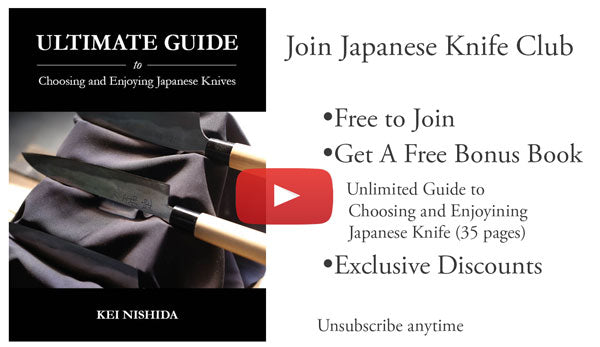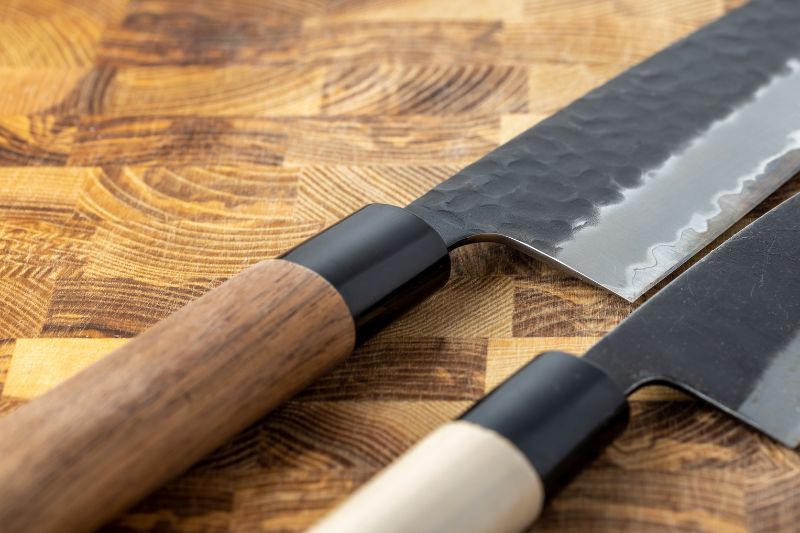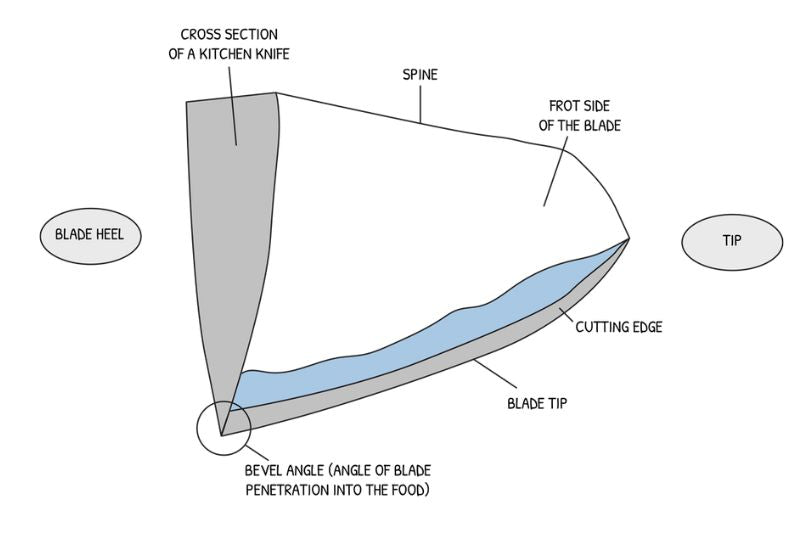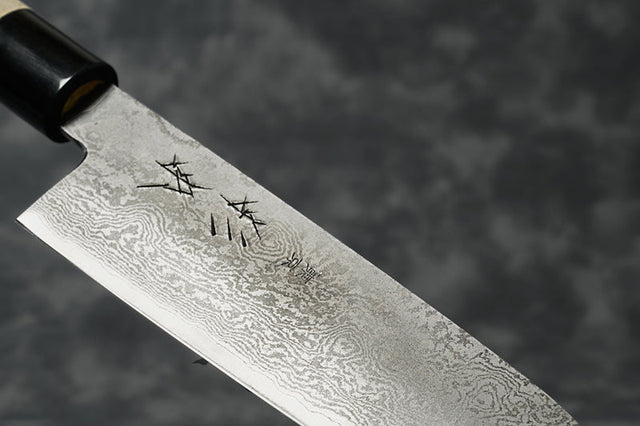Any blade design is good as long as it can effectively slice the food and is safe to use. Japanese Knives are as popular as western knives, but what are their differences, and which is better to use? Let there be a match and know more about these knives.
What are Western-style knives?
Blades used in western knives are typically made of stainless steel or high-carbon stainless steel. These materials offer good corrosion resistance and durability. However, the shape and size of the blade depends on the specific type of knife.
Western-style chef's knives usually have broad, tapered blades that are well-suited for chopping, slicing, and dicing. Paring knives have shorter, pointed blades that are useful for precise cutting tasks. Bread knives typically have serrated blades that can cut through crusty bread without crushing it.
Blades for western knives can be sharpened using various methods, including honing rods, sharpening stones, and electric sharpeners. Maintaining a consistent angle while sharpening the blade is essential to ensure a sharp and even edge.
About Japanese knives
Blades in Japanese knives are typically made of high-carbon steel or a combination of high-carbon steel and other metals like nickel, cobalt, or molybdenum. This type of steel used is known for its hardness, durability, and ability to hold a sharp edge.
The blade shape of Japanese knives can vary widely depending on the type of knife. For example, a gyuto (Japanese-style chef's knife) has a longer and thinner blade than a western-style chef's knife. On the other hand, a nakiri (Japanese-style vegetable knife) has a rectangular-shaped blade that is well-suited for chopping vegetables.
Japanese knives are often sharpened to a sharper angle than western knives, typically around 15-18 degrees per side. The sharpening process is also different, often involving using whetstones to achieve a precise and razor-sharp edge. The blade also tends to be thinner and lighter than a western knife, which can provide greater precision and control during cutting tasks.
Japanese knives and western knives differ in several ways, including:
1. Blade material
Japanese knives often use harder, high-carbon steel, which allows for a sharper, more precise edge than the softer stainless steel commonly used in western knives.
2. Blade shape
Japanese knives tend to have thinner, lighter blades with a sharper angle, which can provide greater precision and control during cutting tasks. Western knives tend to have thicker, heavier blades with a broader edge, which can be better for heavy-duty cutting tasks.
3. Handle
Japanese knives typically have a traditional wooden handle that is often made of magnolia wood. In contrast, western knives usually have a synthetic or plastic handle that may be more durable and easier to clean.
4. Cutting technique
The sharpness and precision of Japanese knives make them well-suited for a slicing technique, while western knives are better for rocking or chopping motions.
5. Price
Japanese knives tend to be more expensive than western knives due to their high-quality materials and craftsmanship.
6. Aesthetics
Japanese knives are often considered works of art, with beautiful and distinctive blade shapes, patterns, and finishes. Western knives tend to have a simpler, more practical design.
Pros of using Western knives over Japanese knives
Some potential pros of using western knives over Japanese knives include the following:
1. Durability
Western knives often use stainless steel or high-carbon stainless steel, which can be more resistant to corrosion and rust than the high-carbon steel used in Japanese knives. These can make western knives more durable and easier to maintain over time.
2. Versatility
Western knives often have a broader, heavier blade with a curved edge that is well-suited for various cutting tasks, including chopping, slicing, and dicing. This versatility can make them a good choice for home cooks who need a single, all-purpose knife.
3. Comfort
Western knives typically have a heavier, more substantial handle that can be more comfortable to grip and maneuver, especially for people with larger hands or who are new to using knives.
4. Lower cost
Western knives are often less expensive than Japanese ones, making them a more affordable choice for home cooks on a budget.
Pros of using Japanese knives over Western knives
Some potential pros of using Japanese knives over western knives:
1. Sharpness
Japanese knives are typically made of harder steel, which allows for a sharper, more precise edge that can make cutting and slicing tasks easier and more efficient.
2. Lightweight
Japanese knives often have thinner, lighter blades and handles, which can provide greater precision and control during cutting tasks. These blades can make them a good choice for delicate or intricate cutting tasks.
3. Cutting technique
The sharpness and precision of Japanese knives make them well-suited for a slicing technique, which can help to maintain the integrity and flavor of delicate ingredients like fish and vegetables.
4. Aesthetics
Japanese knives are often considered works of art, with beautiful and distinctive blade shapes, patterns, and finishes that can add a touch of elegance to any kitchen.
5. Craftsmanship
Japanese knives are often made by skilled artisans who use traditional techniques and take great pride in their work. their work can result in knives of exceptional quality and durability.
Overall, it's important to note that both types of knives have their strengths and weaknesses, and the choice of which to use may depend on personal preference, the kind of cutting task, and the user's level of experience.
Get Free Bonus Books

Sign up for free to the Japanese Knife Club to get advice and exclusive articles about how to choose Japanese Knives, and tips and tricks for using Japanese knives.
About the author
Kei Nishida
Author, CEO Dream of Japan
Certification: PMP, BS in Computer Science
Education: Western Washington University
Kei Nishida is a passionate advocate of Japanese craftsmanship, a writer, and the founder and CEO of Japanese Knife Co., Japanese Green Tea Co., and Japanese Coffee Co., all part of Dream of Japan.
His journey began with a mission to introduce the world to the exquisite flavors of Japanese green tea. Through Japanese Green Tea Co., he pioneered the import of premium tea grown in nutrient-rich sugarcane soil, earning multiple Global Tea Champion awards. He then expanded into the world of coffee, launching Japanese Coffee Co., the first company to bring Sumiyaki charcoal-roasted coffee to a global audience.
With a deep appreciation for Japanese artistry and tradition, Kei turned his attention to one of Japan’s most revered crafts: bladesmithing. Through Japanese Knife Co., he made handcrafted katana-style knives, created by a renowned katana maker, available outside Japan for the first time. These exceptional knives embody centuries of samurai sword-making expertise, blending tradition with modern functionality for chefs and collectors alike.
Kei’s journey continues as he uncovers and shares Japan’s hidden treasures—one sip, one blade, and one legacy at a time.























